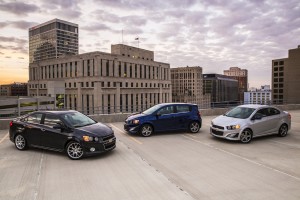
Small cars, like the Chevy Sonic, have helped to push the average fuel economy of vehicles to new heights.
As automakers and the federal government head toward a potential clash over the 54.5 mpg corporate average fuel economy mandate for 2025, a recent study shows that automakers are making substantive gains in fuel economy: about one in four new vehicles get less than 20 mpg.
That’s a significant uptick in just six years, according to the University of Michigan, which show that in 2008, half of new-car buyers in the U.S. bought vehicles that were rated at less than 20 mpg.
The shift is a reflection of several factors that helped push the industry into building and American consumers into buying more fuel-efficient vehicles. The rising price of gasoline, which jumped in wake of a series of hurricanes in fall of 2005, beginning with Hurricane Katrina that swept through the Gulf of Mexico and disrupted the production of gasoline and diesel fuel, set helped renew interest in fuel economy.
Two years after Katrina, the U.S. Congress, with support of environmental groups and national security experts concerned about the risks posed by large imports of crude oil, particularly from the Middle East, finally succeeded in passing a bill that allowed the U.S. Environmental Protection Agency to boost fuel economy standards for the first time in decades.
Fuel-economy standards had been frozen since the late 1980s.
Finally, the 2008-2009 recession pushed American consumers to look for more fuel-efficient vehicles while the long-standing opposition by Detroit’s automakers evaporated under the pressure created by the domestic industry’s financial crisis. The combination of economics, regulation and the resulting investment in fuel efficiency, as well as the advent of electric vehicles, make backsliding very difficult.
The figures from the University of Michigan study underscore the scope of the shift.
The University of Michigan’s research shows average fuel economy has improved 4.5 miles per gallon between model years 2008 and 2014, University of Michigan researchers Michael Sivak and Brandon Schoettle document sales-weighted distributions for the same model year vehicles.
(Congressman pushes nationwide traffic camera ban. For more, Click Here.)
The new report found that improvements are present throughout the distributions of vehicle fuel economy.
About 24% of new 2008 vehicles bought reported fuel economy ratings between 11 mpg and 17 mpg, and 26% purchased vehicles got between 17 and 20 mpg. Six years later, less than 9% of car buyers purchased a new 2014 model with fuel economy less than 17 mpg. Another 19% drove new cars that averaged between 17 mpg and 20 mpg.
(Click Here for details about why recall levels will remain high.)
While about 35% of new vehicles sold in 2008 had average fuel economy between 20 mpg and 26 mpg, compared to roughly 31% for model year 2014, huge improvements were made in the sales of fuel-efficient cars, the researchers say.
Nearly 41% of new-car buyers bought 2014 vehicles with mpg of at least 26, including 27% who purchased vehicles averaging at least 30 mpg. In 2008, the corresponding figures were 15% and 5%, respectively.
(To see more about the rise in February auto sales, Click Here.)
Overall, average fuel economy for light-duty vehicles improved from 20.8 mpg for model year 2008 to 25.3 mpg for model year 2014, the last full year for which results are available.

Auto makers have little choice with the absurd Obama/EPA decree of 54.5 mpg. Consumers will pay dearly for this technically meritless decree. Will the EPA and Mr. Obama buy back all the junk inoperable EVs in five years at the customer full purchase price?